unit 1 helping those in need教案
牛津深圳版英语八下Unit 1《Helping those in need》基础教学设计

牛津深圳版英语八下Unit 1《Helping those in need》基础教学设计一. 教材分析牛津深圳版英语八下Unit 1《Helping those in need》的主题是帮助有需要的人。
本单元通过介绍各种志愿者活动和公益事业,让学生学会如何去帮助他人,培养他们的关爱他人、回馈社会的意识。
教材包括听力、口语、阅读和写作等多个方面的内容,旨在全面提高学生的英语能力。
二. 学情分析学生在学习本单元前,已经掌握了基本的英语语法和词汇,具备一定的听说读写能力。
但部分学生对一些特殊语法结构和高级词汇的使用还不够熟练,同时,对于如何运用英语描述实际生活中的事件和情感还存在一定的困难。
三. 教学目标1.能熟练运用本单元所学词汇和语法描述志愿者活动和公益事业。
2.提高听说读写能力,能流利地用英语进行交流和表达。
3.培养关爱他人、回馈社会的意识,增强社会责任感。
四. 教学重难点1.重点:本单元的词汇和语法,如何运用英语描述志愿者活动和公益事业。
2.难点:如何运用英语表达实际生活中的情感和感受。
五. 教学方法采用任务型教学法,以学生为主体,教师为主导,通过各种教学活动,激发学生的学习兴趣,提高他们的英语能力。
六. 教学准备1.准备相关志愿者活动和公益事业的图片、视频等教学素材。
2.准备本单元的生词和语法点,以及相关练习题。
3.准备课堂用语和教学指导手册。
七. 教学过程1.导入(5分钟)利用图片和视频介绍志愿者活动和公益事业,激发学生的学习兴趣,引出本课主题。
2.呈现(10分钟)讲解本单元的生词和语法点,让学生通过观察和理解,掌握新知识。
3.操练(15分钟)通过各种口语练习,让学生熟练运用本单元的词汇和语法进行交流和表达。
4.巩固(10分钟)设计相关练习题,让学生在书面表达中运用本单元的知识,巩固所学内容。
5.拓展(10分钟)让学生分组讨论,结合自己的生活经验,用英语描述一次志愿者活动或公益事业,培养他们的关爱他人、回馈社会的意识。
Unit1Helpingthoseinneed大单元整体教学设计牛津深圳版(广州沈阳通用)八年级英语

单元整体教学设计表二:单元大观念:主题大观念小观念1:了解志愿服务的目的、对象、活动形式和心情感受等小观念2: 了解如何组织一个筹款活动并能通过请求信报请批准。
小观念3:了解更多志愿服务活动和组织,树立社会服务意识。
单元大观念:了解志愿服务的目的、主要形式、内容和意义,培养奉献精神和社会责任感输出:完成一份报告,记叙自己参与某一志愿服务的经历,说明自己参与志愿活动的目的以及感受和收获,并鼓励更多的人参与志愿服务活动帮助有困难的人。
输出:设计一份小组参加志愿服务活动的方案。
输出:就自己班打算参与的志愿服务活动,写一封请求信报请学校批准。
输出:写一份申请信,申请成为某一志愿服务活动或组织的志愿者。
Reading:三位学生在假期做志愿者的经历。
Grammar:动词不定式描述志愿活动的内容以及目的。
Listening:听一段有关募集善款活动的广播采访录音。
Talk time: 学习表示确定或不确定的打算货意愿的表达方式。
Speak up:谈论自己打算参与的志愿服务活动。
Writing:写一封请求校长批准筹款活动的请求信。
More practice:了解“春蕾计划”。
Culture corner:了解“联合国儿童基金会”。
核心素养的综合表现:学生能够运用与志愿服务相关的词汇和表达方式描述志愿服务的经历、阐述志愿服务的目的以及分析志愿服务的意义。
学情分析(一)自然情况本单元围绕“帮助有困难的人”这一话题,以志愿服务为主线,开展教学活动,了解志愿服务的目的、主要形式、内容和意义,培养奉献精神和社会责任感。
符合Module 1 Social munication 这个话题的内容探究,以及八年级学生对知识的汲取需求。
语言大观念小观念1:围绕语义整合性学习词汇和表达方式小观念2:围绕本单元所学目标语言点,写一封请求书,请求校长批准筹款活动。
志愿服务的对象、具体内容、目的和意义描述方式语篇结构 志愿服务活动和组织及机构voluntary work, in need, raise, disabled, offer, suffer, serious, illness, organize, express, pain, lonely, difficulty, hurt, joy, peace, friendship, courage, spiritsbud, fund, project, unable, be unable to, percent, launch, rent, supplies, disaster, longterm, protection1. 活动目的、时间和地点:in order to, the purpose of, help, think about…2. 活动安排:decide to do sth., prepare for…, invite sb. to do sth., hold, organize, activity…3. 收获:helpful, important, learn about, have an influence on…4. 请求 Could you please give sb. permission to do sth.GreetingPara.1: Why you are writing the letter Para.2: How you are going to raise money Para.3: When and where you would like to have the activityPara.4: What you would like to head teacher to do Closing。
Unit 1 Helping those in need
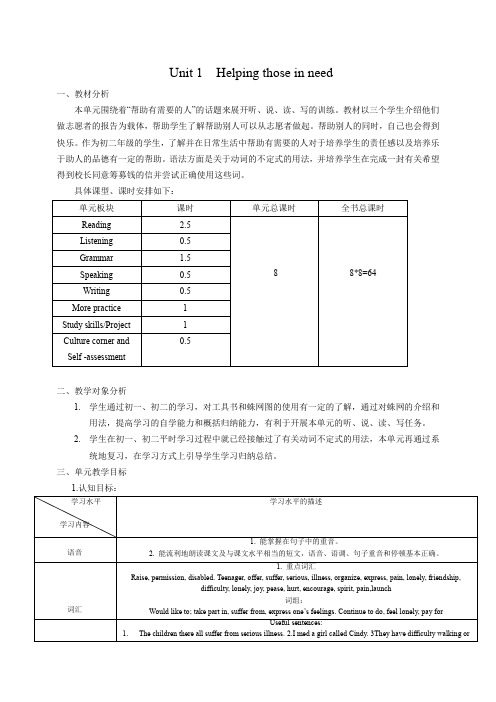
Unit 1 Helping those in need一、教材分析本单元围绕着“帮助有需要的人”的话题来展开听、说、读、写的训练。
教材以三个学生介绍他们做志愿者的报告为载体,帮助学生了解帮助别人可以从志愿者做起。
帮助别人的同时,自己也会得到快乐。
作为初二年级的学生,了解并在日常生活中帮助有需要的人对于培养学生的责任感以及培养乐于助人的品德有一定的帮助。
语法方面是关于动词的不定式的用法,并培养学生在完成一封有关希望得到校长同意筹募钱的信并尝试正确使用这些词。
具体课型、课时安排如下:二、教学对象分析1.学生通过初一、初二的学习,对工具书和蛛网图的使用有一定的了解,通过对蛛网的介绍和用法,提高学习的自学能力和概括归纳能力,有利于开展本单元的听、说、读、写任务。
2.学生在初一、初二平时学习过程中就已经接触过了有关动词不定式的用法,本单元再通过系统地复习,在学习方式上引导学生学习归纳总结。
三、单元教学目标1.认知目标:2. 思想情感目标:1)通过谈论“助人”的相关话题,帮助学生培养乐于助人的道德情感。
2)结合课文的内容,引导学生通过乐于助人,帮助那些有需要的人,从而提高学生的道德感和社会责任感。
3. 能力发展目标:1)能够在听、说、读、写等语言综合实践活动中运用本单元的重点词汇、句型与语法。
2)在学习中提高交流和传递信息的能力,在写作中正确运用连词使文章更连贯和流畅。
3)通过指导学生在模拟交际中运用所学的知识,培养学生探究学习、合作学习、自主学习的能力。
四、单元教学重点1. 学生熟练掌握重点词语,词组及句型。
2.指导学生利用所学句型正确表达思想、进行交际活动。
3.指导学生归纳、总结动词不定式的用法,并在实践运用中熟练运用。
五、单元教学难点1.动词不定式的归纳整理及运用。
六、教学策略1. 引导学生积极主动的通过预习完成可以自己学会的部分,课堂学习完成学习的重难点,通过复习及归纳总结完善单元的学习。
2. 在教学中以旧带新,引导学生用正确的句子表达思想。
新牛津深圳版八年级英语下册《Unit 1 Helping those in need》教案:Reading2
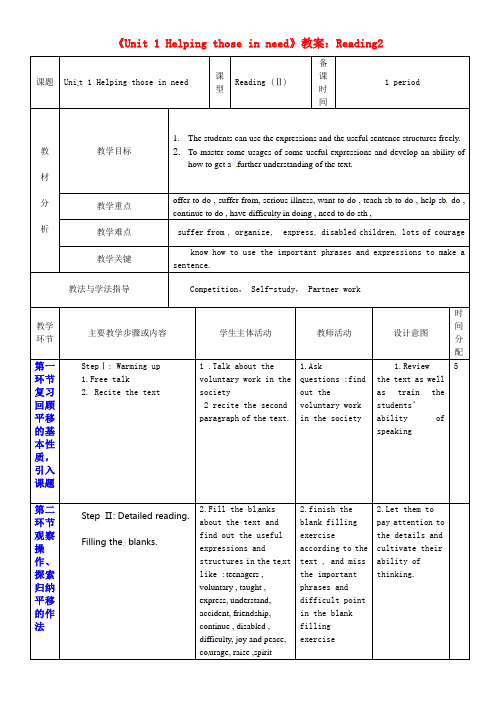
suffer from , organize, express, disabled children, lots of courage
教学关键
know how to use the important phrases and expressions to make a sentence.
教法与学法指导
4.Give them an example to do th e exercise.
work in group to check the answers.
4.to consolidate the usage of the key points of the text
《Unit 1 Helping those in need》教案:Reading2
课题
Uni t 1 Helping those in need
课型
Reading教
材
分
析
教学目标
1.The students can use the expressions and the useful sentence structures freely.
2.To master some usages of some useful expressions and develop an ability of how to get a further understanding of the text.
教学重点
offer to do , suffer from, serious illness, want to do , teach sb to do , help sb do , continue to do , have difficulty in doing , need to do sth ,
牛津深圳版英语八下Unit1《Helpingthoseinneed》基础说课稿
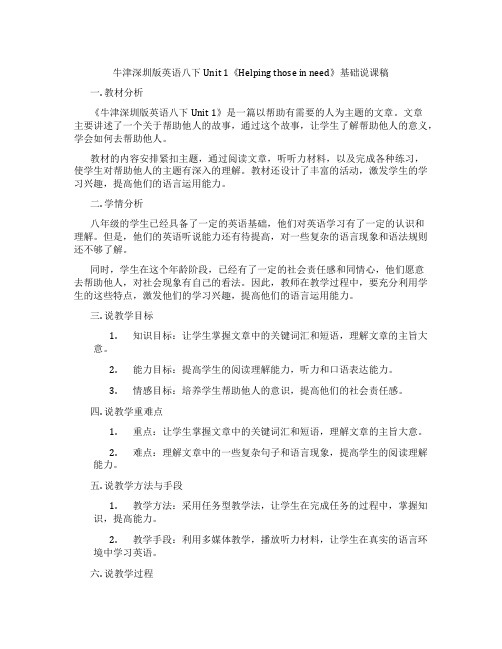
牛津深圳版英语八下Unit 1《Helping those in need》基础说课稿一. 教材分析《牛津深圳版英语八下Unit 1》是一篇以帮助有需要的人为主题的文章。
文章主要讲述了一个关于帮助他人的故事,通过这个故事,让学生了解帮助他人的意义,学会如何去帮助他人。
教材的内容安排紧扣主题,通过阅读文章,听听力材料,以及完成各种练习,使学生对帮助他人的主题有深入的理解。
教材还设计了丰富的活动,激发学生的学习兴趣,提高他们的语言运用能力。
二. 学情分析八年级的学生已经具备了一定的英语基础,他们对英语学习有了一定的认识和理解。
但是,他们的英语听说能力还有待提高,对一些复杂的语言现象和语法规则还不够了解。
同时,学生在这个年龄阶段,已经有了一定的社会责任感和同情心,他们愿意去帮助他人,对社会现象有自己的看法。
因此,教师在教学过程中,要充分利用学生的这些特点,激发他们的学习兴趣,提高他们的语言运用能力。
三. 说教学目标1.知识目标:让学生掌握文章中的关键词汇和短语,理解文章的主旨大意。
2.能力目标:提高学生的阅读理解能力,听力和口语表达能力。
3.情感目标:培养学生帮助他人的意识,提高他们的社会责任感。
四. 说教学重难点1.重点:让学生掌握文章中的关键词汇和短语,理解文章的主旨大意。
2.难点:理解文章中的一些复杂句子和语言现象,提高学生的阅读理解能力。
五. 说教学方法与手段1.教学方法:采用任务型教学法,让学生在完成任务的过程中,掌握知识,提高能力。
2.教学手段:利用多媒体教学,播放听力材料,让学生在真实的语言环境中学习英语。
六. 说教学过程1.导入:利用图片或故事引入主题,激发学生的学习兴趣。
2.阅读理解:让学生阅读文章,回答相关问题,理解文章的主旨大意。
3.听力理解:播放听力材料,让学生完成相关练习,提高他们的听力能力。
4.口语表达:让学生根据文章内容,进行角色扮演或讨论,提高他们的口语表达能力。
5.语法讲解:讲解文章中的一些复杂句子和语言现象,帮助学生提高阅读理解能力。
Unit 1 Help those in need 基础教案

Unit 1 Helping those in need1.raise v.筹募raise money意为―募集钱款‖。
The students are raising money for the people who lost homes in the earthquake.v.增加;提高How can we raise English levels in a short time? 提高英语水平【提示】raise是一个及物动词,后可直接跟宾语。
其常见的释义和用法还有:(1)使上升;使升起:We can see soldiers raise the national flag on Tian'anmen Square every morning.(2)提及;提起:The book raises many questions for readers to think about.(3)抚养;养育;培养:Father raised the family.(4)饲养;喂养:I want to raise a dog as my pet.【辨析】raise与riseraise,及物动词,―使上升;使升起‖。
一般指日常生活中的事物上升。
如:举起了杯子、提高了租金. rise,不及物动词,(rise-rose-risen)。
说明一些自然现象的升起。
如:日、月、云、雾、烟、蒸汽、河水、温度、物价以及人的职位等.【小试】I. 用上述动词的正确形式完成下列句子。
(1).He _________ his head to look at me.(2).The people’s living standard has greatly been ______.(3).Her temperature is still ______.II. 从A、B、C、D四个选项中,选出可以填入空白处的最佳选项。
(1).The prices are ______ fast these days. Nobody can get the prices down.A. going downB. risingC. raisingD. brought down.(2).They’ve ______ up to 20,000yuan for the Hope Project.A. roseB. raiseC. raisedD. risen2.permission n.准许;批准不可数名词Jim took the laptop without permission.ask permission意为―报请批准‖。
2020年牛津深圳版八年级英语下册《Unit 1 Helping those in need》教案:Writing

《Unit 1 Helping those in need》教案:Writing课题Unit1 Helping those in need 课型Writing备课时间1 Period教材分析教学目标1.To know how to write a letter to your head teacher to askpermission.教学重点When writing the passage, students should know what ways they willuse to raise money to help others教学难点 When and where would you like to have the activity?教学关键 discuss the ways to raise money教法与学法指导Self-study, Cooperation, Group work.教学环节主要教学步骤或内容学生主体活动教师活动设计意图时间分配第一环节复习回顾平移的基本性质,引入课题StepⅠ:Free talk andpreparation for writing1. talk about how theywill raise themoney ,and fill in thechart in Part A1. Sum u p theirways to raisemoney1.To arousetheir interestabout the class5第二环节观察操作、探索归纳平移的作法StepⅡ: Answer th e qu estions inPart B,2.Write down theanswers to thequestions in Part B2.lead studentsto organizetheir answersto be a passage2.To train theirability toe xpress as wellas improve theirspeakingability and toget ready forthe writing andtrain theirability to10cooperate.第三环节课堂练习Step II I: Writinge 3. Write aletteraccording to thetips in Part C,and check thearticles3.remind students topay attention totheir handwritingand check themistakes studentsmake3.To train thestudents’writing ability.15第四环节课时小结Step IV Sum upHo w t o organize the writing.4. find out the rulesof writing a letter4.List thebeautifulse ntences theywrite in thepassages4.Let them getfamiliar withthe writing.5第五环节课后作业1. Recite the passage which given as a sample .课堂教学流程Free ta lk and preparation →Read a sample passage →write a passage—Check the writhing.效果评价与反思。
牛津深圳版英语八年级下unit_1《helping_those_in_need》word单元教案教案

《形成气候的主要因素》教案第一课时教学目标1. 学会分析纬度位置、海陆分布、地形地势、人类活动等因素对气候的影响。
2. 举出日常生活中的实例,说明气候对生产和生活的影响。
教学重点学会分析纬度位置、海陆分布、地形地势、人类活动等因素对气候的影响。
教学难点综合分析由于海水和陆地比热容的差异,导致海陆气候的不同。
教学方法合作探究法、读图分析法课前准备世界年平均气温分布图、世界年平均降水量分布图课时安排2课时教学过程一、导课引入:出示“世界年平均气温分布图”、“世界年平均降水量分布图”,说出赤道和两极气温和降水方面的不同。
(赤道地区气温高降水多;两极地区气温低降水少。
)(使用“学乐师生”APP拍照\录像\录音,收集学生典型成果,在“授课”系统中展示。
)二、新授板书:(一)纬度因素地球的形状与气候1.请同学们回顾一下:从早晨到中午再到晚上,感受到的气温的变化是怎样?(早晨冷、中午热、晚上冷)2.设问:为什么早晨、晚上冷,中午热呢?(早晨、晚上和中午太阳的照射角度不同)3.用手电筒从不同的角度照射墙壁:先直射,后斜射,引导学生观察墙壁上光线明亮程度的不同。
问:观察到了什么现象?(墙面上光照明暗程度不同:直射时光束明亮而集中,斜射时光束分散而暗淡)4.有谁观察到或能解释是什么原因造成这样的差异?(手电筒照射的角度不同)5.让学生读图比较阳光照射角度的不同对地面所获得的热量的影响。
6.教师在此引出并简单介绍什么是“太阳高度角”。
(太阳光线与地平面的夹角)7.活动:做相关活动。
8.总结:太阳光线垂直照射的地方,太阳高度大,太阳辐射强;太阳斜射的地方,太阳高度小,太阳辐射弱。
由于地球是个不规则的球体,所以同一时间内各地太阳高度角不同,所获得的太阳辐射不同,气温高低不同。
承转:不仅同一时间不同地点的气候有差异,而且同一地点不同时间的气候也有差异。
地球的运动与气候1.出示表格如下,引导学生回顾已学过的知识,讨论“地球自转运动”和“地球公转运动”的不同。
牛津深圳英语八年级下册Unit1Helpingthoseinneed第四课时Writing教学设计

(二)过程与方法
在本节课中,学生将通过以下过程与方法提高英语素养:
1.通过小组讨论,引导学生关注社会弱势群体,培养他们的同理心和关爱意识。
2.通过阅读范文,分析文章结构、写作技巧,让学生学会如何组织一篇关于帮助他人的作文。
2.通过小组讨论,让学生分享自己曾经帮助他人或得到他人帮助的经历,从而导入本节课的主题。
3.结合课本内容,讲解重点词汇和句型,并通过示例、练习等方式,帮助学生巩固所学知识。
4.针对写作技巧,设计一系列练习,如段落展开、连接词使用等,让学生在实际操作中掌握写作方法。
5.引导学生进行小组合作,共同完成一篇关于帮助他人的作文。在此过程中,鼓励学生相互交流、讨论,提高写作能力。
四、教学内容与过程
(一)导新课(500字)
1.教师通过多媒体展示一组图片,内容包括贫困地区的孩子、残疾人士、自然灾害中的受难者等,引导学生关注这些需要帮助的人群。
2.邀请学生分享他们曾经帮助他人或得到他人帮助的经历,让学生在真实情境中感受帮助他人的重要性。
3.引导学生思考以下问题:“How can we help those in need?” “Why is it important to help others?”,为接下来的课堂内容做铺垫。
3.教师引导学生关注讨论过程中的观点和论据,为后续写作积累素材。
(四)课堂练习(500字)
1.教师设计一份关于帮助他人的写作练习,要求学生运用所学的词汇、句型和写作技巧完成作文。
2.学生在规定时间内完成作文,教师巡回指导,解答学生在写作过程中遇到的问题。
3.学生完成作文后,进行同伴互评,互相指出优点和不足,并提出改进意见。
Unit 1 Helping those in need教案21

Unit 1 Helping those in needPeriod 3 Grammar一、学习目标:1、掌握动词不定式的结构2、掌握动词不定式作宾语、宾语补足语和目的状语的用法。
3、掌握不带to的动词不定式的用法。
二、课前检测:用括号中所给词的正确形式填空。
1) It is interesting __________(swim) in summer.2) The boy ordered his dog __________ (lie) down.3) She told me __________ (clean) my bedroom.4) The teacher asked us __________ (be) quiet.5) Tom decides __________ (go) to Beijing.三、自学指导1:1、考虑动词的形式都包括哪些?2、动词不定式的基本形式是什么?有哪些特点?动词不定式基本形式:______________(在某些情况下可以把to省掉)特点:A .______(有/没有)人称和数的变化B . ______(可以/不可以)有自己的宾语和状语C . ______(有/没有)时态和语态的变化四、自学指导2:1、哪些动词后面可以跟to do形式?2、动词不定式在句子中都做什么成分?点拨:1、动词不定式作宾语1>动词+ to do常见动词有want, forget, remrember, need, try, learn, like, agree, wish, decide, begin, start, pretend2>动词+疑问词+ to doI don’t know what to do .I don’t know how to do it / that.3>动词+ it(形式宾语)+宾补+to dofind + it + adj. + to do sth.练习:1> He decided ___________ (buy) the camera.2>I want _____________ (listen to) some music after class.3>I hope ____________ (travel) all over the world one day.4>I don’t know ____________________(去哪里) .5>I don’t know ____________________(什么时候出发) .6>I don’t know ____________________(选择哪个) .7>I find it hard ______ (get) on well with him .8>I find it easy ______ (fall) asleep in hot summer.9>完成第7页的Part A。
牛津深圳版八年级下英语Unit1Helpingthoseinneed教案
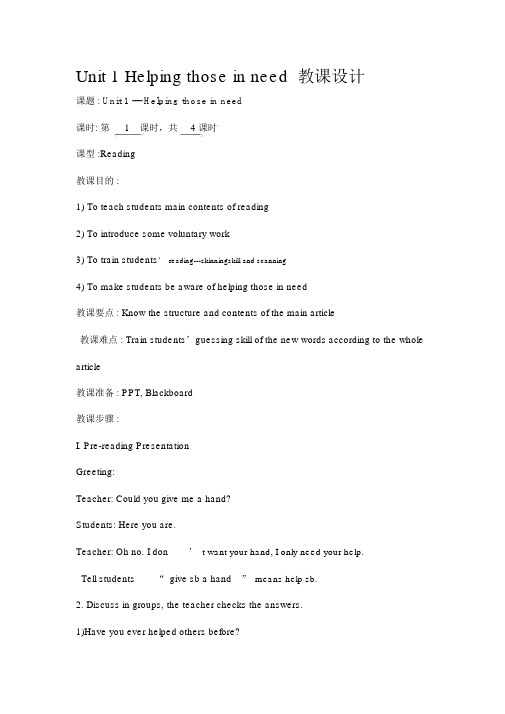
Unit 1 Helping those in need 教课设计课题 : Unit 1 --- Helping those in need课时: 第1课时,共 4 课时课型 :Reading教课目的 :1)To teach students main contents of reading2)To introduce some voluntary work3)To train students’ reading---skinningskill and scanning4)To make students be aware of helping those in need教课要点 : Know the structure and contents of the main article教课难点 : Train students’guessing skill of the new words according to the whole article教课准备 : PPT, Blackboard教课步骤 :I. Pre-reading PresentationGreeting:Teacher: Could you give me a hand?Students: Here you are.Teacher: Oh no. I don’ t want your hand, I only need your help.Tell students“ give sb a hand” means help sb.2.Discuss in groups, the teacher checks the answers.1)Have you ever helped others before?2)Why do (not) you want to help others ?3)How do you feel if you give others ’a hand?3.Learning important words and phrases(.学习要点单词及短语) Answer the Qs in A&B1.raise v.筹募raise money意为“召募钱款”。
牛津深圳版英语八年级下unit_1《helping_those_in_need》word重点内容汇编教案
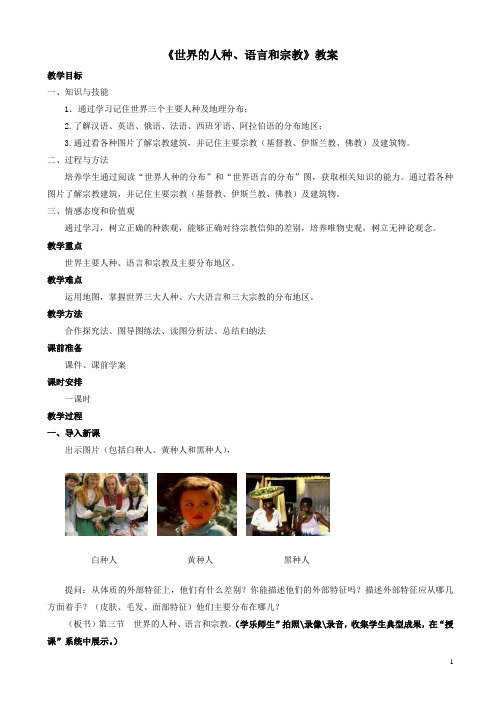
《世界的人种、语言和宗教》教案教学目标一、知识与技能1.通过学习记住世界三个主要人种及地理分布;2.了解汉语、英语、俄语、法语、西班牙语、阿拉伯语的分布地区;3.通过看各种图片了解宗教建筑,并记住主要宗教(基督教、伊斯兰教、佛教)及建筑物。
二、过程与方法培养学生通过阅读“世界人种的分布”和“世界语言的分布”图,获取相关知识的能力。
通过看各种图片了解宗教建筑,并记住主要宗教(基督教、伊斯兰教、佛教)及建筑物。
三、情感态度和价值观通过学习,树立正确的种族观,能够正确对待宗教信仰的差别,培养唯物史观,树立无神论观念。
教学重点世界主要人种、语言和宗教及主要分布地区。
教学难点运用地图,掌握世界三大人种、六大语言和三大宗教的分布地区。
教学方法合作探究法、图导图练法、读图分析法、总结归纳法课前准备课件、课前学案课时安排一课时教学过程一、导入新课出示图片(包括白种人、黄种人和黑种人),白种人黄种人黑种人提问:从体质的外部特征上,他们有什么差别?你能描述他们的外部特征吗?描述外部特征应从哪几方面着手?(皮肤、毛发、面部特征)他们主要分布在哪儿?(板书)第三节世界的人种、语言和宗教。
(学乐师生”拍照\录像\录音,收集学生典型成果,在“授课”系统中展示。
)二、新课学习1.世界的人种(展示)“世界人种分布图”做读图填表:相当隔离地生活在不同的地理环境下的缘故。
朗读“阅读材料”了解环境对人种的影响。
(展示)“世界人种分布图”,做练习1)非洲北部、亚洲西部和印度北部主要分布着什么人种?(白种人)2)除亚洲外,还有哪几洲黄种人较多?(北美洲北部、南美洲)3)印度南部分布着哪两个人种?(白种人和黑种人)4)我国有没有白种人分布的地方?是什么民族?(新疆;维吾尔族、哈萨克族)(过渡)不同的种族分布在不同的地方。
长期的生活,形成了他们独特的生活方式,也形成了他们特有的语言。
他们的存在,构成了世界的丰富多彩。
下面我们就听一听他们的语言,谁知道这是那种外语?用录音机分别录一小段英、俄、日、法、西班牙广播或歌曲,让同学们猜或让学生模仿。
牛津深圳版八年级英语下册Unit1Helpingthoseinneed优质教案Reading2

教案3课题Uni t 1 Helping those in need 课型Reading (Ⅱ)备课时间1 period教材教学目标1.The students can use the expressions and the useful sentencestructures freely.2.To master some usages of some useful expressions and develop anability of how to get a further understanding of the text.教学重点do , help sb do , continue to do , have difficulty in doing , need to第二观察的作Step Ⅱ: DetailedFilling the blanks.2.Fill the bl anksfind out the usefulstructures in the te xtcontinue , disabled ,peace, co urage,do , have difficultyin doing , need to do2.finish theexercisetext , and missfillingpaper whichcontain the2.Let them tothe details andability ofstudents’cooperation and第三环节课堂练习Step VI: More practice 4. Use the right formsof the expressions tofinish the sentences.Translate the Chinesesentences intoEnglish by using theimportant phrases inthe text4.Give them anexample to doth e exercise.work in group tocheck theanswers.4. toconsolidate theusage of the keypoints of thetextlet students usethe usefulexpressionsthey learned第四环节课时小结Step Ⅵ: sum up 6.write down andremember theimportant points ofthis class.6.Show a PPT andsum up the mainpoints of thetext and leadstudents toread it.2. Make sen tences。
英语八年级下unit_1《helping_those_in_need》word基础教案
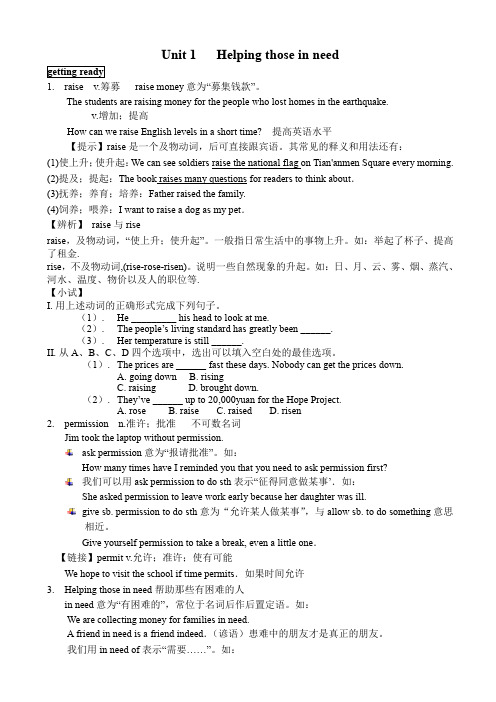
Unit 1 Helping those in need1.raise v.筹募raise money意为“募集钱款”。
The students are raising money for the people who lost homes in the earthquake.v.增加;提高How can we raise English levels in a short time? 提高英语水平【提示】raise是一个及物动词,后可直接跟宾语。
其常见的释义和用法还有:(1)使上升;使升起:We can see soldiers raise the national flag on Tian'anmen Square every morning.(2)提及;提起:The book raises many questions for readers to think about.(3)抚养;养育;培养:Father raised the family.(4)饲养;喂养:I want to raise a dog as my pet.【辨析】raise与riseraise,及物动词,“使上升;使升起”。
一般指日常生活中的事物上升。
如:举起了杯子、提高了租金.rise,不及物动词,(rise-rose-risen)。
说明一些自然现象的升起。
如:日、月、云、雾、烟、蒸汽、河水、温度、物价以及人的职位等.【小试】I. 用上述动词的正确形式完成下列句子。
(1).He _________ his head to look at me.(2).The people’s living standard has greatly been ______.(3).Her temperature is still ______.II. 从A、B、C、D四个选项中,选出可以填入空白处的最佳选项。
(1).The prices are ______ fast these days. Nobody can get the prices down.A. going downB. risingC. raisingD. brought down.(2).They’ve ______ up to 20,000yuan for the Hope Project.A. roseB. raiseC. raisedD. risen2.permission n.准许;批准不可数名词Jim took the laptop without permission.ask permission意为“报请批准”。
(完整版)Unit1Helpthoseinneed语法教案
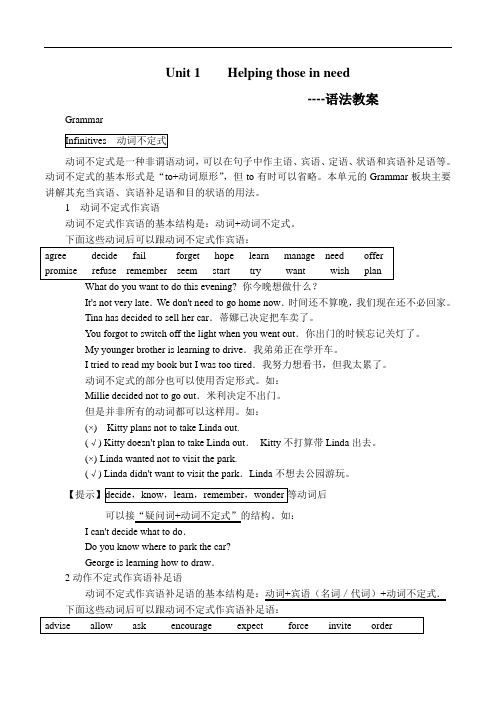
Unit 1 Helping those in need----语法教案Grammar动词不定式是一种非谓语动词,可以在句子中作主语、宾语、定语、状语和宾语补足语等。
动词不定式的基本形式是“to+动词原形”,但to有时可以省略。
本单元的Grammar板块主要讲解其充当宾语、宾语补足语和目的状语的用法。
1 动词不定式作宾语动词不定式作宾语的基本结构是:动词+动词不定式。
下面这些动词后可以跟动词不定式作宾语:What do you want to do this evening? 你今晚想做什么?It's not very late.We don't need to go home now.时间还不算晚,我们现在还不必回家。
Tina has decided to sell her car.蒂娜已决定把车卖了。
You forgot to switch off the light when you went out.你出门的时候忘记关灯了。
My younger brother is learning to drive.我弟弟正在学开车。
I tried to read my book but I was too tired.我努力想看书,但我太累了。
动词不定式的部分也可以使用否定形式。
如:Millie decided not to go out.米利决定不出门。
但是并非所有的动词都可以这样用。
如:(×) Kitty plans not to take Linda out.(√) Kitty doesn't plan to take Linda out.Kitty不打算带Linda出去。
(×) Linda wanted not to visit the park.(√) Linda didn't want to visit the park.Linda不想去公园游玩。
牛津深圳版八年级英语下册Unit1Helpingthoseinneed优质教案Grammar
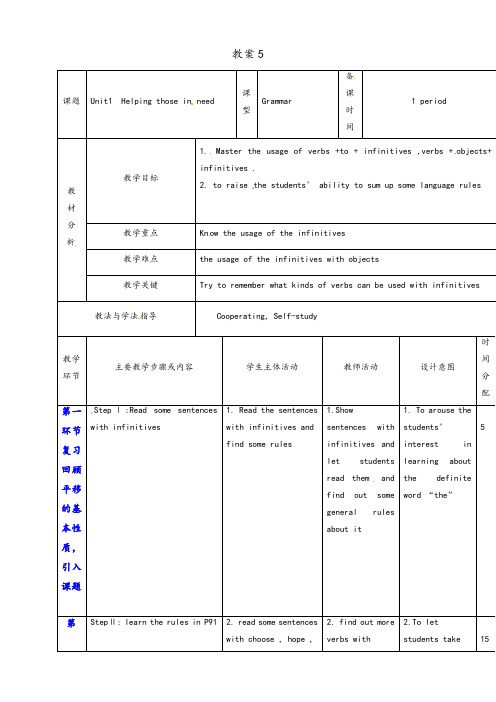
3. su m up the rules about the usage of the structures :verb +object +infinitive
Check the answer of Part B
4. give more sentences with infinitives which express purpose.
2.To let students take part in the class actively and know the rules of the usage ofinfinitives
StepStep V: more practice
5.finish the exercise given by teacher and practice the usage oftheandwith
5. hand out the sheets and let students finish the exercise in it
教法与学法 指导
Cooperating, Self-study
教学环节
主要教学步骤或内容
学生主体活动
教师活动
设计意图
时间
分配
第一环节 复习回顾平移的基本性质,引入课题
StepⅠ:Read some sentences with infinitives
1. Read the sentences with infinitives and find some rules
课
堂
教
Unit1Helpthoseinneed基础教案
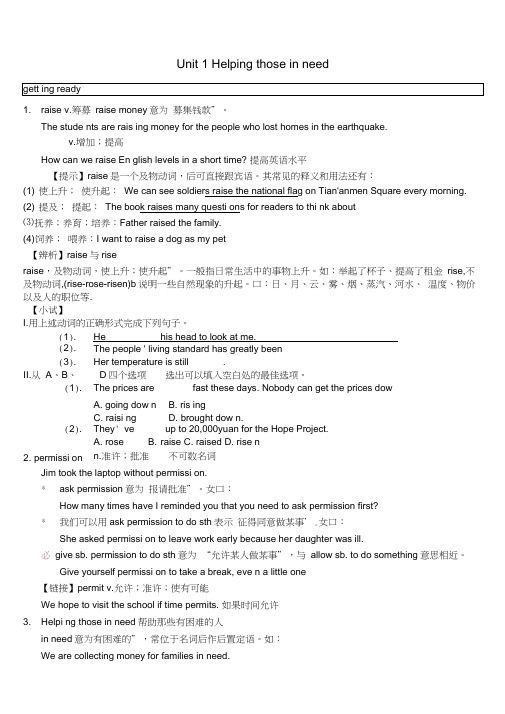
Unit 1 Helping those in need1. raise v.筹募raise money意为募集钱款”。
The stude nts are rais ing money for the people who lost homes in the earthquake.v.增加;提高How can we raise En glish levels in a short time? 提高英语水平【提示】raise是一个及物动词,后可直接跟宾语。
其常见的释义和用法还有:(1) 使上升;使升起:We can see soldiers raise the national flag on Tian'anmen Square every morning.(2) 提及;提起:The book raises many questi ons for readers to thi nk about⑶抚养;养育;培养:Father raised the family.(4)饲养;喂养:I want to raise a dog as my pet【辨析】raise与riseraise,及物动词,使上升;使升起”。
一般指日常生活中的事物上升。
如:举起了杯子、提高了租金rise,不及物动词,(rise-rose-risen)b说明一些自然现象的升起。
口:日、月、云、雾、烟、蒸汽、河水、温度、物价以及人的职位等.【小试】I.用上述动词的正确形式完成下列句子。
(1). He his head to look at me.(2). The people ' living standard has greatly been(3). Her temperature is still .II.从A、B、C、D四个选项中,选出可以填入空白处的最佳选项。
(1). The prices are fast these days. Nobody can get the prices downA. going dow nB. ris ingC. raisi ngD. brought dow n.(2). They' ve up to 20,000yuan for the Hope Project.A. roseB. raiseC. raisedD. rise n2. permissi on n.准许;批准不可数名词Jim took the laptop without permissi on.*ask permission意为报请批准”。
教学设计:Helpingthoseinneed【全国一等奖】
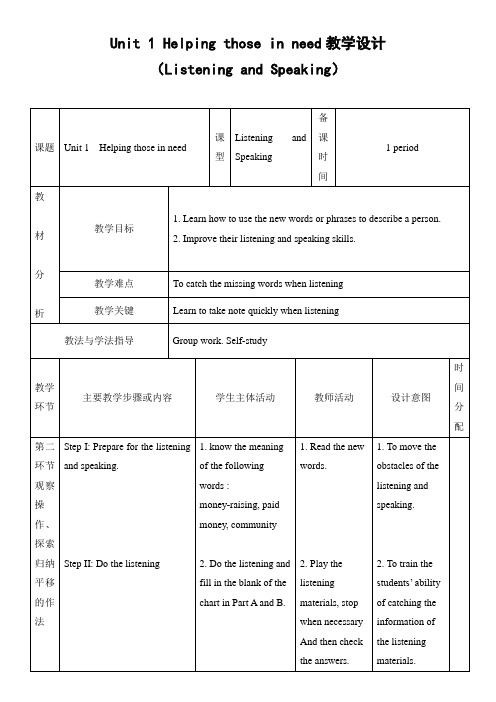
果
评
价
与
反
思
1.To move the obstacles of the listening and speaking.
2.To train the students’ ability of catching the information of the listening materials.
3.To develop the students’ ability of listening and speaking.
第五环节 课后作业
Discuss with your classmates in what way will you raise money for the people in need?
课
堂
教
学
流
程
Prepare for listening → Listening →Speaking→Summary
1. Read the new words.
2.Play the listening materials, stop when necessary
And then check the answers.
3.Give a sample dialogue to students and ask them to imitate it.
2.Improve their listening and speaking skills.
教学难点
To catch the missing words when listening
教学关键
Learn to take note quickly when listening
教法与学法指导
2020年牛津深圳版八年级英语下册《Unit 1 Helping those in need》教案:Words

《Unit 1 Helping those in need》教案:Words课题Unit 1 Helping those in need 课型NEW WORDS备课时间1 period教材分析教学目标1.Let students know the meaning o f the new words andcan use the words to make sentences2.Train the students ability of cooperation教学重点The pronunciation and the usages of the new words: raise, disabled,offer, serious, illness, organize, lonely, difficulty , hurt, pay 教学难点permission , suffer, courage, spirits , community教学关键Let all the students can read the words and know the meaning ofthe new words教法与学法指导Use some pictures and games and PPT教学环节主要教学步骤或内容学生主体活动教师活动设计意图时间分配第一环节复习回顾平移的基本性质,引入课题Step one: Warming up.Freely talk: What have you everdone to help others?Talk with the teac herabout the things theyhave done to helpothers?1.sum up thethings studentsdo to helpothers1.To arousethe interest andlead them toget into thewords of the newwords5第二环节观察操作、探索归纳平移的作法Step two: Newwords.Read the new words.2. Read the news wordsaccording to thesyllables and learnhow to pronounce it3. try to remember thenew words as quicklyas you can, with the2.Play theMP3 of the newwords for themand lead them toread in a properway.3. help thestudents whenthey have2.Let thestudents readsthe wordscorrectly.3.To make themget fami liarwith the20Step three: group work to remember the new wordsStep four: Key words learning. help of the groupleader, then checkwith each ot herwhether you rememberthe words or no t .4. Work in groups tolearn the usage of thekey words, payattention to thefollowing usages ofthe new words : raise,disabled, offer, serious,illness, organize, lonely,difficulty , hurt, pay,suffer5. match the new wordsand the pictures shownon the ppttrouble inreading the newwords4.Show the PPTof the meaningof the key wordsand let ss makemore sentenceswith the newwords5. check the wordsand give themmarks for thegroupspronunciationand the spellingof the newwords.4. Train thestudents’ability tocooperate. Letthe students indifferent levescan take part inthe activity.5.Provie thechances tostudents to showthemselves andpractice thespeakingability.Step five: have a competition第三环节课堂练习Step six: exercise1. use the correct forms ofthe words to fill in theblanks like :He fell from the trees andgot hurt___________(serious).6. Finish theexercise given onthe sheet.6.Collect themistakes in thestudents’exercise.6. to consulatethe usages ofthe new words10第四环节课时小结step SevenHow many words do youmaster?Play a word game to checkwhether they have rememberthe new words.7. Remember the wordsyou learn and spellthem out . Guess theword in the game.7.Give them apiece of paperto write thewords. Play aword game withstudents7.To develop thestudents’ability of self–checking.5第五环节课后作业1.Dictatione the new words tomake sentences onyour own or checkthem in adictionary4. Ask one student tolead all the studentsto read the new word.one student read onenew words.1.Dictation2.correct themistakesStrengthen theremembering ofthe words andsee if they canuse the wordscorrectly课堂教学流程Read the new words --- Games and remember the new words ---- learn the usages of the new words -----Exercise----check how they master the new words。
- 1、下载文档前请自行甄别文档内容的完整性,平台不提供额外的编辑、内容补充、找答案等附加服务。
- 2、"仅部分预览"的文档,不可在线预览部分如存在完整性等问题,可反馈申请退款(可完整预览的文档不适用该条件!)。
- 3、如文档侵犯您的权益,请联系客服反馈,我们会尽快为您处理(人工客服工作时间:9:00-18:30)。
6.lonely与alone的区别。lonely强调感情色彩,如He feels lonely. alone强调孤单一人,如He lives alone.
7.difficulty have difficulty(in)doing sth.
基本结构:to +动词原形(除谓语外,其他均可充当)
1.作宾语常作及物动词的宾语:want wish begin start need forget
decide ask learn would like offer plan等
2.疑问词+to do可做宾语主语
How to control the water pollution is a big problem.
二.给学生听写单词并提问有关单词的知识点。
单词知识点如下:
1.raise筹集raise money
2.permission准许ask permission/without permission
3.offer主动提出offer sb. sth./offer to do sth.
4.suffer遭受suffer from His child is suffering a bad cold.
8.讲解pay cost spend take的用法
1pay与for连用主语为人I paid 10 yuan for the pen.
2Spend主语为人sb.spend +money/time (in) doing sth.
sb.spend +money/time on sth.
I spent 10 yuan buying the pen
I let her finish homework by herself.
五.写相关练习
(因本次课为复习课,学生们已做过笔记,则本次课采取老师提问,学生回答的上课方式!)
成功在于不断地坚持!
2.called过去分词作后置定语与named一样
3.take photos of
4.there be句型(不能说there have)
5.teach sb. to do sth.
6.talk to/with sb. talk about谈论
7.help sb. do /with sth.
8.die-died-dying
I don’t know what to do next.
3.形式宾语I find/think it +形容词+to do sth.
I find it difficult to learn Japanese well.
4.不定式to在使役动词感官动词后要省略。
( have let make feel hear notice see watch等)
I spent 10 yuan on the pen.
③cost主语为物The pen cost me 10 yuan.
④take It takes sb. some money to do sth.
It took me 10 yuan to buy the pen.
三.给学生讲解课文知识点
1.during在……期间
-dead-death (die为非延续动词,不能与一段时பைடு நூலகம்连用,改be dead)
9. have trouble/difficulty /problem (in) doing sth.
Have fun (in) doing sth.
10.like介词像look like/be like
四.语法:动词不定式
教师教案
学员:教师:课程:
授课时间:年月日时分至时第( )次课
教学
内容
Unit 1 Helping those in need
教学
目标
1.掌握unit 1的单词并听写
2.掌握老师要求背诵的知识点并提问
教学
重点
难点
1、要求学生能读和听写unit 1的单词与短语
2、灵活运用知识点
教学
过程
一.讲解上次课练习题
